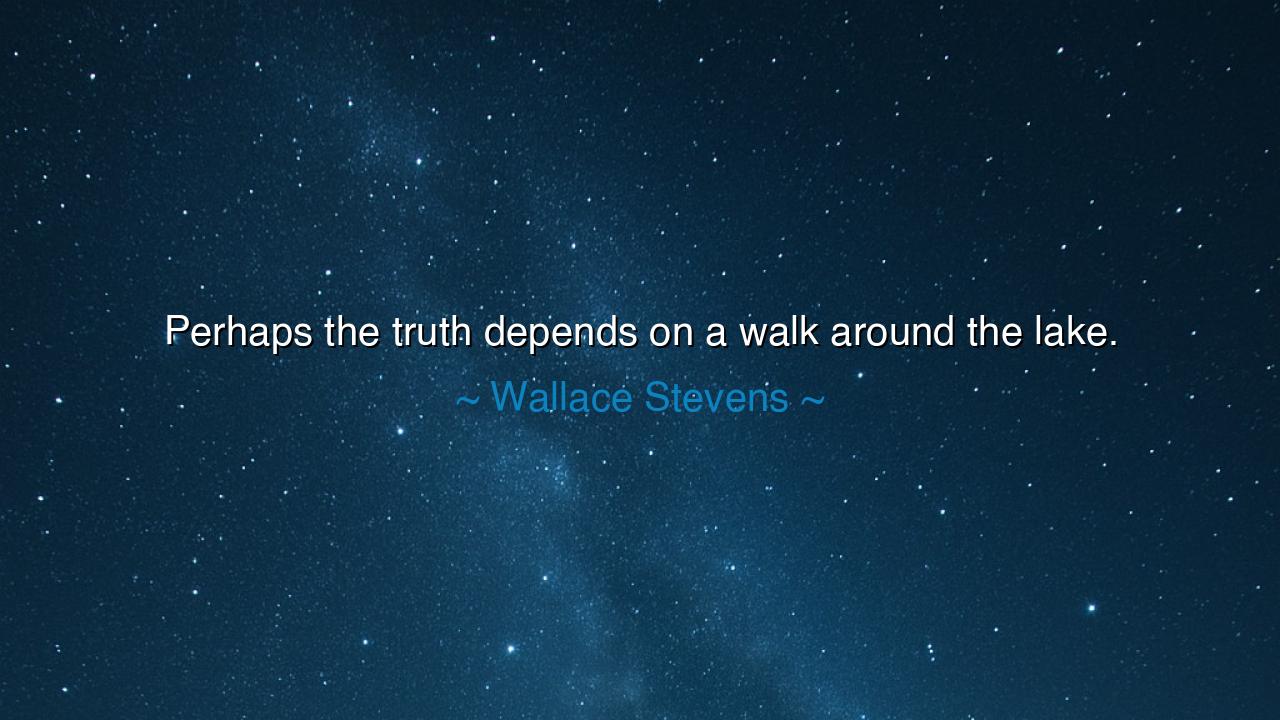
Perhaps the truth depends on a walk around the lake.






"Perhaps the truth depends on a walk around the lake." — so mused Wallace Stevens, the philosopher-poet who clothed thought in shimmering images. This line, soft as a ripple upon water, is yet filled with a depth that the hurried spirit may overlook. He speaks not of logic sharpened to a blade, nor of truth won by conquest of the intellect, but of truth discovered through contemplation, patience, and movement. For truth, like the lake, is not beheld in a single glance; it reveals itself only as one walks its full circumference, seeing how it changes with the angle of the sun, the shift of the clouds, the wandering of the eye.
What Stevens reminds us is that truth is not static. One cannot stand in one place and say, “Here is the whole of it.” The view from the northern shore is not the same as the view from the southern; the waters gleam differently at dawn than at dusk; the reflection shifts as the wind stirs the surface. Likewise, truth must be approached from many sides, considered in its variety, lived through time. To rush, to cling to the first sight, is to mistake the part for the whole. Only the slow circling, the willingness to look again and again, allows truth to rise from mystery to clarity.
Consider the story of Mahatma Gandhi. When confronted with the immense injustice of colonial rule, he did not claim instant knowledge of the right path. He walked around the lake of truth—literally and figuratively. He tested methods of resistance, studied scriptures of many faiths, listened to the cries of the oppressed. Over years, his vision clarified: that non-violence was not weakness, but the deepest truth of human dignity. Had he seized upon the first impulse—to meet violence with violence—he would have betrayed the truth. But by circling the lake, he found a reflection both eternal and transformative.
So too in our daily lives. How often do we seize too quickly upon “my truth,” as though the first impression, the first opinion, the first fragment of experience is the whole? In anger, in haste, we proclaim certainty. Yet if we only paused, walked a little farther, sought another angle, we would see how much was hidden from the first glance. Truth is patient, and it asks for patience in return. The lake does not give itself in one reflection; it offers countless mirrors, each one partial, each one true in its way, yet incomplete.
From this saying we learn humility: that truth is larger than perspective, and perspective requires movement. We must be willing to walk, to wait, to see again. This is not weakness, but wisdom. The ancient philosophers taught the same. Heraclitus declared that one never steps into the same river twice, for both river and man are changed. Stevens echoes this, teaching that to know truth we must step again and again, each time discovering something new.
What, then, is the lesson for us? It is this: do not rush to final judgment. When you face conflict, when you seek understanding, when you wrestle with the mysteries of life—take the walk around the lake. Listen to voices not your own, reflect in moments of stillness, allow time and distance to soften the rigidities of the mind. You will find that truth is not seized in conquest, but revealed in journey.
Practical action lies in simple acts. Walk in nature when your spirit is clouded, for the turning path will teach your mind to turn. Listen to someone you disagree with, and let their vision be another step around the lake. Revisit old convictions with fresh eyes, and ask whether the waters reflect something new. In this way, you will grow into one who seeks not the shadow of truth, but its fullness.
Thus, O seeker, carry Stevens’ wisdom with you: truth is a lake, and you must walk its shores. Do not mistake a single reflection for the whole. Be patient, be humble, and let the journey itself be your teacher. For in the slow circling, in the quiet steps, in the willingness to see anew, you will find that truth—ever elusive, ever radiant—waits to be revealed.






TTTuan Ton
I find this idea so profound. It implies that truth may not be something easily grasped, but something that requires effort and movement. The ‘walk around the lake’ suggests that truth may change depending on how and when we seek it. What if our understanding of the truth is different each time we revisit it? Can truth be a process of discovery rather than a final destination?
DTNguyen Duy Trieu
This quote seems to suggest that truth is not something absolute or fixed—it’s dynamic and often requires exploration. Like walking around a lake, we might need to take the time to observe the surroundings and find different angles. Could the walk represent the journey of self-discovery or understanding? Maybe truth isn't found in one place, but unfolds as we experience life and reflect on our surroundings.
ANAnh Nguyen
I love how this quote suggests that truth isn’t always immediate, but may depend on time and perspective. Walking around a lake gives a sense of change with each step, and perhaps Stevens is saying that truth reveals itself when we take the time to approach it from multiple viewpoints. Is truth always more complex than it seems at first, and do we need to be patient to fully understand it?
DTHai Dang Tran
This quote makes me think about how truth can be something elusive, shaped by our perspective and experiences. Sometimes, it takes stepping back and looking at a situation from different angles, like walking around a lake. Is truth something we can only grasp after exploring it fully? Maybe it’s not a one-time realization, but something we uncover gradually as we move through different experiences.